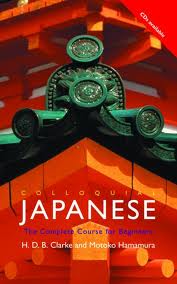Becoming fluent in Japanese can be tough and even the simple task of learning useful phrases for everyday conversation can be challenging. Colloquial Japanese, a book that focuses on simple daily Japanese, is a great tool to make this daunting task more bearable. This book is easy to use, doesn’t require any previous knowledge and it teaches students just what they need to know.
Overview
In each lesson the student will begin by working on activities that will help them practice writing new characters (Hiragana, Katakana and Kanji), followed by listening comprehension exercises, reading activities (written in both English and Japanese), vocabulary charts, some matching exercises and occasionally some review activities. Each chapter works on a number of different subjects, but it follows this specific flow all throughout the book.
"What’s good about this book is that all the sample dialogues are written using the Japanese writing system and Romaji (Japanese written out in the English alphabet). This is useful for those who can read Japanese and for those who are just starting out."
Colloquial Japanese teaches just that, colloquial, or conversational Japanese language skills. There are 15 chapters in this book which cover conversational topics like work, formal introductions, shopping, common questions, suggestions/advice and much more. Each unit includes listening sections, reading activities, review of grammar points and writing exercises. Since this book is specially designed for independent learners rather than classrooms, the book does not come with any speaking activities. What’s good about this book is that all the sample dialogues are written using the Japanese writing system and Romaji (Japanese written out in the English alphabet). This is useful for those who can read Japanese and for those who are just starting out. The book is heavy on the text and there are barely any pictures or illustrations which might bore or even overwhelm some students.
Another good thing about the book is that the listening/reading portions all consist of dialogues between Japanese and foreign speakers. This gives the student an idea of how both parties communicate with each other and it also offers some insight on common speaking errors students might make. There’s lots of vocabulary in each chapter and plenty of commonly used Kanji (Chinese characters used in Japanese) all throughout the book. This book however, seems to be more of a grammar book than a speaking aid due to the many technical explanations and writing exercises provided in each chapter. This structure may be good for the more book-based learner but it won’t seem too useful for students who want to work on developing their speaking and listening skills.

Pros:
· The book teaches students commonly used expressions and informal phrases that the typical course book does not teach.
· Due to the structure of the book, both absolute beginners and more advanced students can work with this book.
· The grammar summary section in the back provides extra information about difficult grammar structures.
Cons:
· The book is text-heavy and fails to maintain the student’s attention at times.
· The book does not provide enough speaking activities.
· The chapters focus too much on verb conjugation exercises.
Recommended For:
· Teachers looking for material to complement their lesson plans.
· Focused and disciplined independent learners.
Depending on your learning style, Colloquial Japanese could be a useful book to work with. It provides lots of useful information, plenty of writing and grammar exercises, and engaging listening activities as well. However, if you’re more of an auditory or visual learner, this book may not be the most appealing. Since the book lacks quite a bit on its own, I would recommend using this book as complementary material to another course book.



